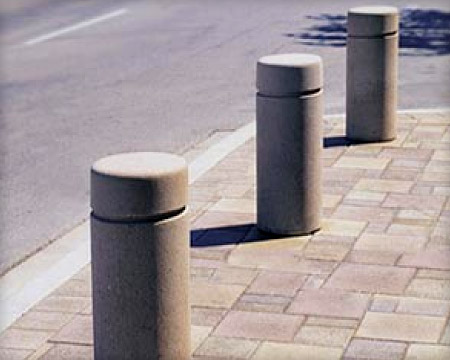See also Street Furniture Overview
A bollard is a short vertical post or similar structure that can define areas in the streetscape and provide an attractive design element. Bollards are often used to separate pedestrians or streetscape elements from vehicles. By placing them in a line, bollards are used to prevent motor vehicles from encroaching on pedestrian space such as sidewalks or plazas.
Attractively designed bollards add color and interest to streetscapes, help define pedestrian spaces, and provide a spot to lean on or rest at.
Process Overview
A Sidewalk Pipe Barrier Permit from the Department of Public Works grants permission to install bollards within the public sidewalk or street right-of-way. For complex projects involving multiple streetscape elements such as bollards street trees, and special paving, etc. DPW may consolidate the required permits into a single encroachment permit.
See Permit Process
DPW Sidewalk Pipe Barrier Permit
Official Codes & Documents
- Better Streets Plan (street design guidelines)
- Downtown Streetscape Plan
(Comprehensive guide to the design of Streets in Downtown San Francisco)
Design Guidelines
Street types: Downtown Commercial, Commercial Throughway, Neighborhood Commercial, Downtown Residential, Residential Throughway, Neighborhood Residential, Industrial, Mixed Use, Parkway, Park Edge, Multi-Way Boulevard, Ceremonial, Alley, Shared Public Way, Paseo
Sidewalk zones: Extension Zone, Edge Zone
Location of bollards
Bollards should be used at sidewalk locations where vehicles attempting to park are damaging sidewalk structures, trees or plantings, furnishings, or adjacent private property, especially on narrow streets.
Bollards should be considered for installation on median islands, curb extensions (except transit bulb-outs), and mid-block curb extensions, where there is a risk of danger to pedestrians due to proximity of travel lanes.
Attractive bollards can also be used in special locations, including pedestrian-oriented spaces such as shared public ways or pedestrian-only streets, to designate unique spaces. Lighted bollards can create a special pedestrian environment, and may be particularly useful to provide additional pedestrian lighting in median refuges.
Removable bollards should be placed at entrances to streets that are closed to vehicles for pedestrian use, to alert drivers to the changed nature of the street. Similarly, removable bollards can define the outside edge of Parklets where the space has been converted to pedestrian use.
Bollards should be placed 18 inches from the back of the curb. If there is no parking in the bollard placement area, the bollard may be installed immediately adjacent to the back of the curb.
Standard bollard spacing is approximately 10 feet on center, but may need to be reduced where there is a need to block vehicular traffic. Spacing should vary to sync with the rhythm of lighting fixtures, trees and landscaping, and other elements in the streetscape.
Design of bollards
Bollards typically range in size from 4 to 10 inches in diameter; decorative bollards can be larger and vary in form.
Bollards should have articulated sides and tops to provide design detail.
Bollards should be painted in colors other than gray to be easily seen by the visually impaired, in colors that complement other streetscape elements.
Bollards should be designed within a ‘family’ of streetscape elements.
In circumstances where bollards are used to temporarily close a street, removable bollards should be designed with long sturdy pipe projections from the bottom that fit into a hole in the ground. Removable bollards should be designed and installed such that, when in place, they are sturdy and look permanent.
Electronic retractable bollards that can be lowered into the roadway to selectively allow vehicles to pass should be considered on streets that are closed to vehicles in order to allow emergency vehicle access while restricting other types of vehicles.
Maintenance
With some exceptions, fronting property owners are responsible for the on-going maintenance and upkeep of sidewalk paving as well as all sidewalk elements directly fronting their property, such as trees, landscaping, and streetscape furnishings. Generally, the City is responsible for maintaining roadway paving and other features in the roadway, such as medians.
Typically, if you initiate street or sidewalk improvements, you will be responsible for maintenance of those features. Specific requirements will be described in your permit.
For a more detailed description of maintenance responsibilities, see Maintenance.







 Copyright © 2015
Copyright © 2015